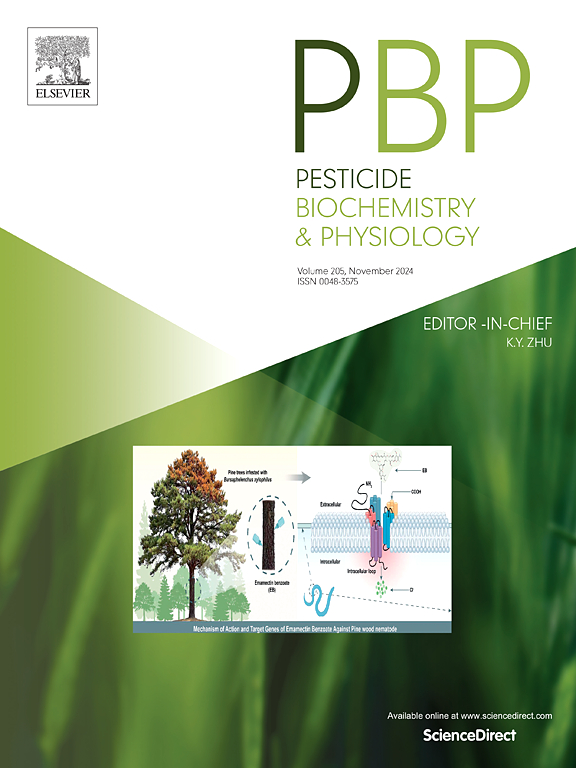RNAi-mediated silencing of CYP4G15 correlates with altered transmission of barley yellow dwarf virus in Sitobion avenae (Fabricius)
IF 4.2
1区 农林科学
Q2 BIOCHEMISTRY & MOLECULAR BIOLOGY
引用次数: 0
Abstract
Insect-borne plant viruses have emerged as major threats to crop production, and the genes of vector insects involved in viral transmission are crucial for effective viral control. However, few studies have identified and functionally validated these genes. A previous study suggested that the aphid protein CYP4G15 interacts with the barley yellow dwarf virus (BYDV; Luteoviridae: Luteovirus) virion in vitro. We hypothesized that the ability of vector aphids to transmit BYDV would be correlated with CYP4G15. To test this hypothesis, we first cloned and analyzed SaCYP4G15 in grain aphid, Sitobion avenae (Fabricius) (Hemiptera: Aphididae), and then examined the expression levels of SaCYP4G15 in S. avenae during the acquisition accession periods (AAPs) and inoculation accession periods (IAPs) of the transmission of the BYDV species PAV (BYDV-PAV). Finally, the role of SaCYP4G15 in the acquisition, retention, and transmission of BYDV-PAV was evaluated by the RNA interference (RNAi) method. The results showed that 1) the coding DNA sequence of SaCYP4G15 was 1701 bp, which corresponds to 566 amino acids, and a transmembrane domain is anticipated to be present at the N-terminus; 2) the expression level of SaCYP4G15 in S. avenae was notably up-regulated in both the AAPs and IAPs of BDYV-PAV transmission; and 3) after knockdown SaCYP4G15, the relative amount of BYDV-PAV in S. avenae decreased during AAPs and increased during IAPs. Additionally, the transmission efficiency of BYDV-PAV during IAPs decreased. These results indicated that SaCYP4G15 in S. avenae correlated with changes in BYDV-PAV transmission by increasing acquisition and transmission efficiency, while decreasing retention. This study extends our knowledge of the interaction between Luteoviridae and vector aphids and suggests that the SaCYP4G15 gene could be a potential target for RNAi-based BYDV control.

rnai介导的CYP4G15沉默与大麦黄矮病毒在青稞中的传播改变相关
昆虫传播的植物病毒已成为作物生产的主要威胁,参与病毒传播的媒介昆虫的基因对于有效控制病毒至关重要。然而,很少有研究鉴定和功能验证这些基因。先前的一项研究表明,蚜虫蛋白CYP4G15与大麦黄矮病毒(BYDV;黄体病毒科:体外的黄体病毒。我们假设媒介蚜虫传播BYDV的能力可能与CYP4G15相关。为了验证这一假设,我们首先克隆并分析了SaCYP4G15在玉米蚜虫Sitobion avenae (Fabricius)(半翅目:蚜虫科)中的表达,然后检测了SaCYP4G15在玉米蚜虫PAV (BYDV-PAV)传播的获取进入期(AAPs)和接种进入期(IAPs)在玉米蚜虫中的表达水平。最后,通过RNA干扰(RNAi)方法评估SaCYP4G15在BYDV-PAV获取、保留和传播中的作用。结果表明:1)SaCYP4G15的编码DNA序列为1701 bp,对应566个氨基酸,预计在n端存在跨膜结构域;2)在BDYV-PAV传播的AAPs和IAPs中,SaCYP4G15在S. avenae中的表达水平均显著上调;3)敲除SaCYP4G15后,葡萄球菌中BYDV-PAV的相对量在AAPs期间下降,在IAPs期间上升。此外,在IAPs期间,BYDV-PAV的传输效率下降。这些结果表明,SaCYP4G15与青花苜蓿BYDV-PAV传播的变化相关,通过提高获取和传播效率,降低保留率。该研究扩展了我们对黄虫病毒科与媒介蚜虫之间相互作用的认识,并提示SaCYP4G15基因可能是基于rnai的BYDV控制的潜在靶标。
本文章由计算机程序翻译,如有差异,请以英文原文为准。
求助全文
约1分钟内获得全文
求助全文
来源期刊
CiteScore
7.00
自引率
8.50%
发文量
238
审稿时长
4.2 months
期刊介绍:
Pesticide Biochemistry and Physiology publishes original scientific articles pertaining to the mode of action of plant protection agents such as insecticides, fungicides, herbicides, and similar compounds, including nonlethal pest control agents, biosynthesis of pheromones, hormones, and plant resistance agents. Manuscripts may include a biochemical, physiological, or molecular study for an understanding of comparative toxicology or selective toxicity of both target and nontarget organisms. Particular interest will be given to studies on the molecular biology of pest control, toxicology, and pesticide resistance.
Research Areas Emphasized Include the Biochemistry and Physiology of:
• Comparative toxicity
• Mode of action
• Pathophysiology
• Plant growth regulators
• Resistance
• Other effects of pesticides on both parasites and hosts.

 求助内容:
求助内容: 应助结果提醒方式:
应助结果提醒方式:


